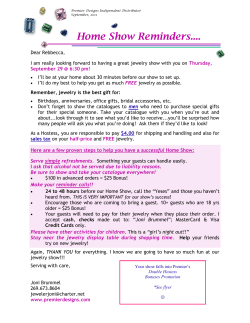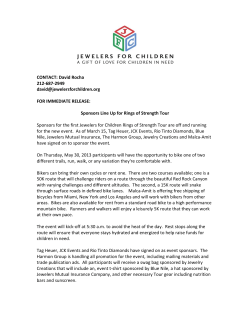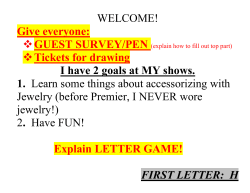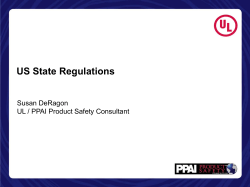
ASTM Publishes Children’s Jewelry Safety Standard
Sparkle Vol. 607 / 25 November 2011 ASTM Publishes Children’s Jewelry Safety Standard th On November 7 ASTM published F2923-11 Standard Specification for Consumer Product Safety for Children’s Jewelry. The standard defines ‘Children’s jewelry’ as jewelry primarily intended for children 12 years of age or younger, which is in line with the definition of children’s product per Consumer Product Safety Improvement Act (CPSIA). The other key definition, jewelry is similar to jewelry as defined in the California State jewelry regulation, and considers following articles worn for adorning as jewelry: 1) Anklet, arm cuff, bracelet, brooch, chain, crown or tiara, cuff link, hair accessory with significant decorative elements, earrings or ear cuffs, necklace, pins (such as tie tacks and trading pins), ring, body piercing jewelry, jewelry placed in the mouth for display or ornament; 2) Any charm, bead, chain, link, pendant or other attachment to shoes or clothing designed to be removed and worn, alone or attached to an item in (1) as an ornament by a person; 3) Watch in which a timepiece is a component of an ornament, excluding the timepiece itself if the timepiece can be removed from the ornament; 4) Jewelry components in craft kits where the final assembled jewelry product is principally designed and intended as an ornament worn by a person. Regional Contacts Asia Pacific 2/F, Garment Centre, 576 Castle Peak Road, Kowloon, Hong Kong Tel: +852 2173 8888 Fax: +852 2786 1903 North America 2107 Swift Dr., Ste 200 Oak Brook, IL 60523 Tel: +1 630 481 3111 Fax: +1 630 481 3101 Latin America rd 8300 N.W. 53 Street, Suite 400, Miami, FL 33166 Tel: +1 305 513 3000 Fax: +1 305 513 2856 Europe, Africa, Middle East ECOPARC 2 27400, Heudebouville, France Tel: +33 2 32 09 36 36 Fax: +33 2 32 09 36 59 Web: www.intertek.com/consumergoods The Challenge: E-mail: consumergoods@intertek.com The standard establishes requirements addressing mechanical hazards as well as toxicological hazards: 1) Lead content in substrates o Applicable to accessible components as determined by 16 CFR 1500.87. Materials exempted per 16 CFR 1500.91 do not require testing. o Requirement: 100 ppm, which is based on CPSIA lead content requirements. o Test Method: Various CPSC standard operating procedures for lead content. 2) Soluble heavy metals o Applicable to paints and surface coatings. o The method and the requirements are the same as the soluble heavy metals requirements in ASTM F963 and EN71-3. 3) Cadmium o Applicable to accessible metal and polymeric/plastic component(s) only. o Requirement: 300 ppm total cadmium content. If total cadmium content of a component exceeds 300 ppm, the manufacturer has two options: For component that are small parts: Metals – extracted cadmium should not exceed 200 µg when tested as per the CPSC acid extraction procedure (CPSC-CHE1004-11). Disclaimer Intertek made all reasonable efforts to ensure the accuracy of the information. However, the information provided should not be relied upon as legal advice or regarded as a substitute for legal advice. The reader should exercise his own care and judgment before relying on this information in any important matter. Copyright © 2011 Intertek Group. All Rights Reserved. Page 1 Sparkle Vol. 607 / 25 November 2011 ASTM Publishes Children’s Jewelry Safety Standard 4) 5) Plastic – extracted cadmium should not exceed 75 ppm when tested per EN71-3. For components that are not small parts: Extracted cadmium from plastic and metal components when tested by 6 hour saline extraction procedure shall not exceed 18 µg. Nickel o Post assemblies inserted in pierced ears or other body piercing: nickel release, 2 when tested per EN 1811, shall not exceed 0.2 µg/cm /week. o Jewelry that will be in prolonged skin contact: nickel release, when tested per EN 2 1811; EN 12472, shall not exceed 0.5 µg/cm /week. Liquid Filled Jewelry o Should meet the requirements for liquid materials specified in ASTM F963. o Should not contain materials listed in 16 CFR 1500.231 and materials that require special labeling in 16 CFR 1500.14. 6) Body piercing jewelry shall be made from specified materials. 7) Children’s jewelry shall not contain a hazardous magnet or hazardous magnetic component, either in as received state or after use & abuse testing. Certain jewelry intended for children 8 years or older may contain hazardous magnet or magnetic component, if the product has appropriate warning label as specified in the standard. 8) To address the strangulation hazard for jewelry intended to be worn around neck, the jewelry is required to have breakaway feature or constructed from such material(s) so that when a 15 lb force is applied by specially designed pulleys the jewelry should release. 9) Hazardous sharp edge or sharp points are not allowed in jewelry for children 8 years of age and younger. Regional Contacts Asia Pacific 2/F, Garment Centre, 576 Castle Peak Road, Kowloon, Hong Kong Tel: +852 2173 8888 Fax: +852 2786 1903 North America 2107 Swift Dr., Ste 200 Oak Brook, IL 60523 Tel: +1 630 481 3111 Fax: +1 630 481 3101 Latin America rd 8300 N.W. 53 Street, Suite 400, Miami, FL 33166 Tel: +1 305 513 3000 Fax: +1 305 513 2856 Europe, Africa, Middle East ECOPARC 2 27400, Heudebouville, France Tel: +33 2 32 09 36 36 Fax: +33 2 32 09 36 59 Web: www.intertek.com/consumergoods E-mail: consumergoods@intertek.com 10) Battery operated children’s jewelry a. Batteries that are small parts per 16 CFR 1501 shall not be accessible b. Labeling for use of appropriate batteries where 2 or more replaceable batteries are used c. Prevention of unintentional charging of rechargeable batteries, when used. d. Permanent polarity marking of battery compartment or area adjacent to the battery compartment 11) Suction tongue studs are prohibited as children’s jewelry. The Solution: Intertek offers an extensive variety of solutions and services to a wide range of industries, including precise analytical methods in verifying the total or soluble concentration of cadmium and other heavy metals content. Should you have any queries on the above news, please contact Mr. Elvis Chan at Tel: (852) 2173-8617 / Mr. Ralph Keung at Tel: (852) 2173-8630 / Fax to (852) 2785-8570 / Email: Intertek.tfh.info@intertek.com Disclaimer Intertek made all reasonable efforts to ensure the accuracy of the information. However, the information provided should not be relied upon as legal advice or regarded as a substitute for legal advice. The reader should exercise his own care and judgment before relying on this information in any important matter. Copyright © 2011 Intertek Group. All Rights Reserved. Page 2
© Copyright 2025





















